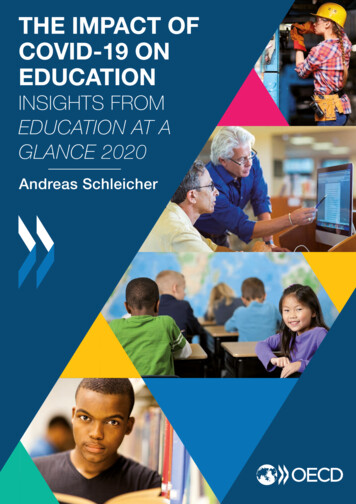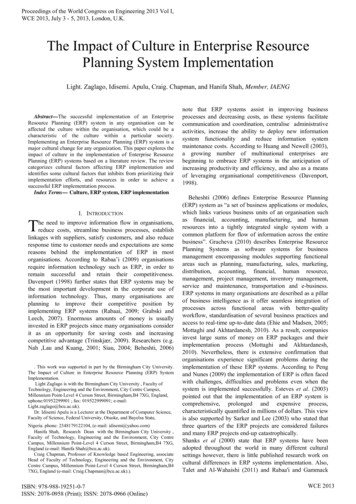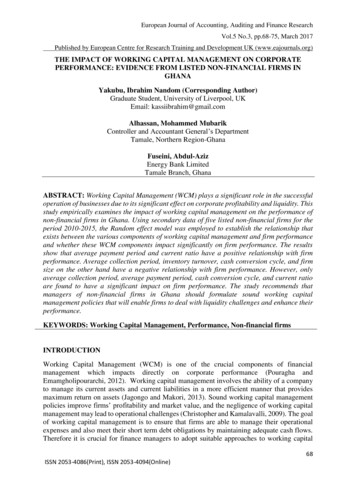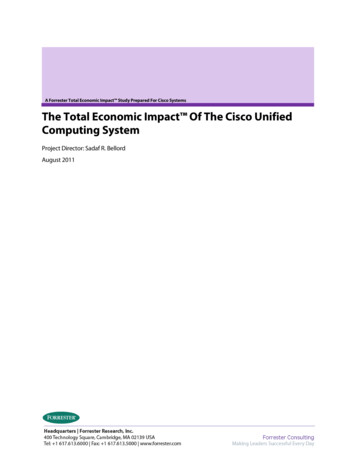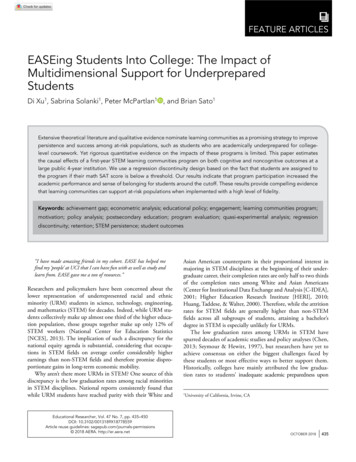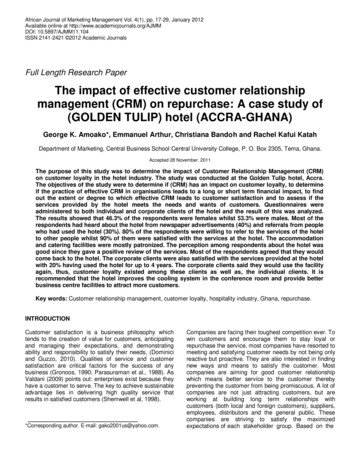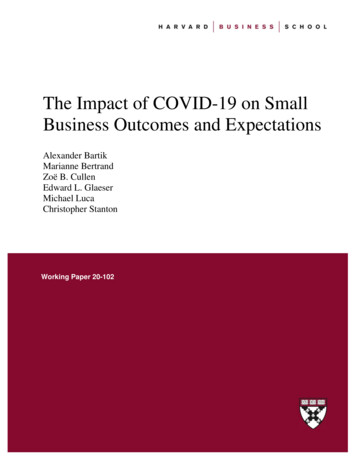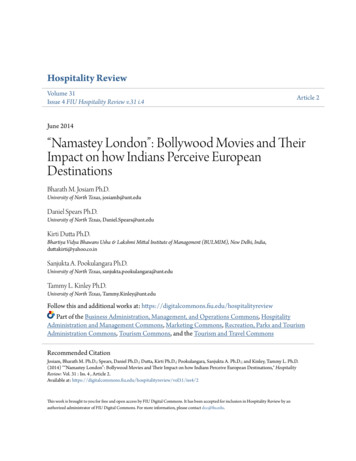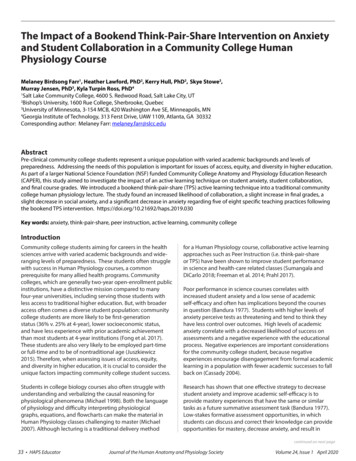
Transcription
The Impact of a Bookend Think-Pair-Share Intervention on Anxietyand Student Collaboration in a Community College HumanPhysiology CourseMelaney Birdsong Farr1, Heather Lawford, PhD2, Kerry Hull, PhD2, Skye Stowe2,Murray Jensen, PhD3, Kyla Turpin Ross, PhD41Salt Lake Community College, 4600 S. Redwood Road, Salt Lake City, UT2Bishop’s University, 1600 Rue College, Sherbrooke, Quebec3University of Minnesota, 3-154 MCB, 420 Washington Ave SE, Minneapolis, MN4Georgia Institute of Technology, 313 Ferst Drive, UAW 1109, Atlanta, GA 30332Corresponding author: Melaney Farr: melaney.farr@slcc.eduAbstractPre-clinical community college students represent a unique population with varied academic backgrounds and levels ofpreparedness. Addressing the needs of this population is important for issues of access, equity, and diversity in higher education.As part of a larger National Science Foundation (NSF) funded Community College Anatomy and Physiology Education Research(CAPER), this study aimed to investigate the impact of an active learning technique on student anxiety, student collaboration,and final course grades. We introduced a bookend think-pair-share (TPS) active learning technique into a traditional communitycollege human physiology lecture. The study found an increased likelihood of collaboration, a slight increase in final grades, aslight decrease in social anxiety, and a significant decrease in anxiety regarding five of eight specific teaching practices followingthe bookend TPS intervention. https://doi.org/10.21692/haps.2019.030Key words: anxiety, think-pair-share, peer instruction, active learning, community collegeIntroductionCommunity college students aiming for careers in the healthsciences arrive with varied academic backgrounds and wideranging levels of preparedness. These students often strugglewith success in Human Physiology courses, a commonprerequisite for many allied health programs. Communitycolleges, which are generally two-year open-enrollment publicinstitutions, have a distinctive mission compared to manyfour-year universities, including serving those students withless access to traditional higher education. But, with broaderaccess often comes a diverse student population: communitycollege students are more likely to be first-generationstatus (36% v. 25% at 4-year), lower socioeconomic status,and have less experience with prior academic achievementthan most students at 4-year institutions (Fong et al. 2017).These students are also very likely to be employed part-timeor full-time and to be of nontraditional age (Juszkiewicz2015). Therefore, when assessing issues of access, equity,and diversity in higher education, it is crucial to consider theunique factors impacting community college student success.for a Human Physiology course, collaborative active learningapproaches such as Peer Instruction (i.e. think-pair-shareor TPS) have been shown to improve student performancein science and health-care related classes (Sumangala andDiCarlo 2018; Freeman et al. 2014; Prahl 2017).Students in college biology courses also often struggle withunderstanding and verbalizing the causal reasoning forphysiological phenomena (Michael 1998). Both the languageof physiology and difficulty interpreting physiologicalgraphs, equations, and flowcharts can make the material inHuman Physiology classes challenging to master (Michael2007). Although lecturing is a traditional delivery methodResearch has shown that one effective strategy to decreasestudent anxiety and improve academic self-efficacy is toprovide mastery experiences that have the same or similartasks as a future summative assessment task (Bandura 1977).Low-stakes formative assessment opportunities, in whichstudents can discuss and correct their knowledge can provideopportunities for mastery, decrease anxiety, and result inPoor performance in science courses correlates withincreased student anxiety and a low sense of academicself-efficacy and often has implications beyond the coursesin question (Bandura 1977). Students with higher levels ofanxiety perceive tests as threatening and tend to think theyhave less control over outcomes. High levels of academicanxiety correlate with a decreased likelihood of success onassessments and a negative experience with the educationalprocess. Negative experiences are important considerationsfor the community college student, because negativeexperiences encourage disengagement from formal academiclearning in a population with fewer academic successes to fallback on (Cassady 2004).continued on next page33 HAPS EducatorJournal of the Human Anatomy and Physiology Society Volume 24, Issue 1 April 2020
The Impact of a Bookend Think-Pair-Share Intervention on Anxiety and Student Collaboration in a Community College Human Physiology Coursebetter performance in summative assessments. Fostering acollaborative, rather than competitive, classroom culture, withpeer interaction, may also help reduce the negative impacts ofstudent anxiety.Mazur (1997) describes a structured series of steps calledPeer Instruction (i.e. think-pair-share or TPS) designed toemphasize student interaction during lectures and focusstudents’ attention on the underlying concepts. The methodbegins with a short conceptual multiple-choice questioncalled a “ConcepTest” that focuses on a single topic. Thetype and phrasing of the question matters, though; openended ConcepTest questions that require verbalization ofprocesses to arrive at a conclusion foster student interactionand discussion more effectively than questions that requirea simple recall of information (Allen and Tanner 2005). Afterpresenting the ConcepTest question, the instructor allowsstudents time to answer the question alone, then providestime to consult with peers and answer the question again,and finally presents the correct answer and provides anopportunity for discussion with the class (Mazur 1997).The TPS technique can easily be modified to include personalresponse systems (PRS) to ensure that every student isparticipating in the activity and to allow the instructor to giveimmediate feedback based on responses received. Anothermodification to the TPS technique is to use the ConcepTestquestion to “bookend” a traditional lecture by posing thequestion, allowing for students to answer individually, thenlecturing over the concept (but not the specific question),before posing the same question again, this time allowingtime for TPS and class discussion. This modificationencourages students to focus attention on the concept initiallywith the presentation of the question, allows them timeto process and critically evaluate their initial response, andprepares them for the discussion that they will have when theyengage in the collaboration step (Smith et al. 2005).Integrating TPS opportunities within a traditional lectureformat provides students the opportunity to verbalize theirthoughts about physiological concepts using appropriateterminology, to correct misconceptions in a low-stakesenvironment, and promotes communication and comparisonof ideas among classmates, and can encourage a collaborative,rather than competitive, classroom culture, especially if theinstructor helps to foster inquiry and reinforces the processas well as correct responses. Paired or small group discussioncan also decrease the anxiety often associated with studentsspeaking out in class, providing a less daunting opportunity toverbalize ideas with one or a few peers first (Tanner 2013).Mazur (1997) states that TPS, “forces the students to thinkthrough the arguments being developed and providesthem (as well as the teacher) with a way to assess theirunderstanding of the concept”. TPS has also been shown toimprove performance on quizzes (Sumangala and DiCarlo2018). In addition, if, as reported, students find the causalreasoning associated with Human Physiology difficult, thenmodeling and providing opportunities to practice this kindof reasoning during class (using carefully worded ConcepTestquestions) with real-time instructor feedback could lead tohigher summative assessment scores and decreased stress(Michael 2007).Although TPS has been implemented and evaluated inmultiple studies, we did not find evidence in the literature thatthe bookend TPS technique had been tested in the communitycollege population.As part of a larger study on pedagogical practices in anatomyand physiology courses at the community college level, thisresearch introduced a bookend TPS technique administeredwith electronic personal response systems into a traditionallecture-based human physiology course and attempted toanswer three questions:1. Does a bookend TPS activity administered duringformative assessment improve final grades?2. Does the use of a TPS activity decrease student anxiety?3. Does a TPS activity increase the likelihood of studentcollaboration?MethodsStudent PopulationThis research was implemented in two 30-student HumanPhysiology (BIOL2420) lecture sections taught at Salt LakeCommunity College (SLCC) by the same instructor. Each classmet twice per week for 80 minutes. Students enrolled inHuman Physiology at SLCC are primarily second-year studentsmajoring in pre-health science or an undeclared major.The majority of these students intend to apply to nursingprograms or other allied health programs such as radiology,occupational therapy assistant, and physical therapy assistant.SLCC students are required to complete Introductory Biologyand Elementary Chemistry with a C or better as a prerequisitefor Human Physiology, and most students have alsocompleted Human Anatomy, although it is not a prerequisitefor the course. Students must also enroll in Human Physiologylaboratory (BIOL2425), as a corequisite. Human Physiologyis often the last course a student will take before applyingto an allied health program or transferring to a four-yearcollege to complete a bachelor’s degree. At SLCC, 42% of ourstudent population self-report as first generation, whereas42% report as not first generation and 14% do not report theirstatus. Moreover, 75% of the student population works morecontinued on next page34 HAPS EducatorJournal of the Human Anatomy and Physiology Society Volume 24, Issue 1 April 2020
The Impact of a Bookend Think-Pair-Share Intervention on Anxiety and Student Collaboration in a Community College Human Physiology Coursethan 30 hours per week (Figure 1). Thus increasing in-classcomprehension in this population with less formal academicexperience and considerable time constraints is crucial tostudent success.Bookend Think-Pair-ShareThe Institutional Review Board (IRB) of Salt Lake CommunityCollege found this research project to be exempt form IRBreview (IRB# 00009566, FWA00021259). Informed consentwas obtained from all participants. TPS questions wereadministered during two 80-minute lecture sections per weekduring Spring semester 2019. During most lecture periods,a conceptual multiple-choice question was presented twice(with a short lecture between the questions). Using Top Hat,an electronic PRS, students answered the question alone,then listened to the material, then collaborated and answeredagain, comparing answers to other student answers, withthe instructor providing anonymous histograms of studentresponses and real-time feedback. Mazur (1997) describes theseven steps that constitute the traditional Peer Instructionmethod as follows.1. Students are presented a conceptual multiple-choicequestion (ConcepTest question). Questions followedpublished guidelines for designing effective multiplechoice questions, with a correct answer and viabledistractors that elicit common misconceptions aboutthe concept (Haladyna et al. 2002). An exampleConcepTest question is provided in Figure 2.All of these factors impact stroke volume. Which ofthese do you predict will DECREASE stroke volume?A increased venous return to the atriaB increased strength of ventricular contractionC increased pressure in the arteries near the heartD increased blood volume in the ventriclesFigure 2. Sample ConcepTest question.2. Students were then given one minute to think beforeanswering the question.3. Students respond using PRS. Student responses andcorrect answers were not shared with the class atthis point. As a modification to Mazur’s original PeerInstruction method, at this point a short lecture waspresented about the physiological concept assessedin the ConcepTest question. The lecture did not coverthe specific question, or the answer the ConcepTestFigure 1. Working students at SLCCquestion, but guided students through understandingthe concept and modeled logic that could be used inanswering the question and the vocabulary used toexplain the concept.4. The same question was presented again after theshort lecture. During the collaboration portionstudents were asked to pair with another studentand discuss what each initially answered. Studentsattempted to convince their partner if their answersdiffer and to verbalize their arguments whether theyagreed or disagreed. Students were instructed to usephysiological terminology presented in the lectureswhen appropriate and to be prepared to discuss theiranswers with the class. This TPS portion was allottedthree to five minutes.5. Students were given one minute to answer the samequestion again.6. The correct answer and an anonymized studentresponse histogram were shared with the class.Students are awarded credit for participation (notfor accuracy) for answering the question aloneand in pairs. This was an important component ofTPS that encourages collaboration and correctingmisconceptions.7. Instructor asked students to share their logic aboutcorrect answers and distractors and guided a classdiscussion about the reasoning used to arrive at thecorrect answer.continued on next page35 HAPS EducatorJournal of the Human Anatomy and Physiology Society Volume 24, Issue 1 April 2020
The Impact of a Bookend Think-Pair-Share Intervention on Anxiety and Student Collaboration in a Community College Human Physiology CourseBecause research indicates that providing mastery experienceswith the same or similar questions used on summativeassessments can reduce student anxiety, similar questions tothose used during think-pair-share were used on summativeassessments as multiple choice, essay, or short answerquestions (Bandura 1977).Grade AnalysisIn order to assure both students and the college IRB thatassignment of final course grades was not influenced byparticipation in the study, grade analysis was performedonly after final student grades were reported to the college.Final grades after the intervention were compared to finalgrades in a previous semester of the same course from thesame instructor, which was used as a control. The previouscourse used for comparison was randomly selected, hadapproximately the same enrollment (30-35 students), also metfor 80-minutes twice per week, used PRS (but not TPS), usedthe same lecture text, had similar lecture exams, and had thesame laboratory activities.researchers, other than the course instructor, independentlycalculated the number of times each theme appeared in thecomments. The independent researchers compared theirresults and came to a consensus.At the end of the semester, students were also asked whetherthe intervention impacted the likelihood that they would forma study group or collaborate with other students. Open-endedcomments from students regarding the intervention werecollected and will be presented in the results section.ResultsGradesStudents performed better on each bookend TPS questionafter a short lecture and collaborating with their peers.Although students were given credit for participationregardless of the accuracy of answers, we calculated thepercent correct on each bookend ConcepTest question, beforeand after collaboration. On average, students scored 62%correct on ConcepTest questions before collaboration and 86%correct after (Figure 3).Anxiety and CollaborationStudents were asked to complete a self-report measure ratingtheir agreement with statements related to anxiety on aLikert scale at the beginning and the end of the semester. Totest whether social anxiety changed with the treatment, weperformed a dependent t-test on student reports of socialanxiety using a modified Mini-SPIN general and social anxietyinventory before (N 67) and after the treatment (N 51)(Connor et al. 2001, Pintrich and DeGroot 1990). Test anxietywas measured using items from the Revised Test Anxiety Scale(RTA) (McIlroy et al. 2000).Student anxiety regarding specific in-class teaching practiceswas measured using items from an existing sub-scale of avalidated instrument designed to measure anxiety levelstoward research, modified to measure anxiety levels towardbiology instruction (England et al. 2017). We tested fordifferences in anxiety pre- and post-treatment about eightin-class teaching practices: listening to a PowerPoint lecture,volunteering answers posed by the instructor, answering coldcall questions, individual low-stakes ( 5% of grade) quizzing,group low-stakes quizzing, TPS, PRS quizzing in pairs, and PRSquizzing alone. Significant differences in task-related anxietywere identified using MANOVA using SPSS statistical software(Field 2013).Figure 3. Percent correct responses to ConcepTestquestions, pre- and post-TPS collaboration(mean /- SD; ***, P 0.001).Student responses to the question “Do you have anycomments or suggestions about the use of Think-Pair-Share,especially in challenging courses?“ were subjected to thematicanalysis. The comments were examined for common themes,and trigger words for each theme were identified. Twocontinued on next page36 HAPS EducatorJournal of the Human Anatomy and Physiology Society Volume 24, Issue 1 April 2020
The Impact of a Bookend Think-Pair-Share Intervention on Anxiety and Student Collaboration in a Community College Human Physiology CourseWe assessed whether this modified TPS techniqueadministered during formative assessments improved finalcourse grades. In order to test this, we ran an independentt-test comparing the final grades of a randomly-selectedprevious spring semester (in which the technique wasn’tused) to the final grades of this semester. We found a modest,but not significant, difference, in which students using thebookend TPS instruction technique performed slightly better(mean 83.0827 SD 13.38369) compared to those studentsfrom a previous semester who did not use the technique(mean 78.5590, SD 14.45638 ), t(111) - 1.72, p .089.AnxietyWhile Mini-SPIN measures of social anxiety were lower in thepost test (N 51 M 2.97 SD 1.20) compared to pretest(N 67 mean 3.24 SD 1.06), this difference did not reachsignificance, t(48) 1.628, p .11.A MANOVA of anxiety reports regarding eight specific in-classactivities showed a significant difference in anxiety levelsfrom pre to post, F(3,46) 8.434, p .001 (Figure 5). Follow-upunivariate analysis reveals that there was no significant anxietydifference in three of the activities: listening to a lecture,volunteering answers posed by the instructor, and cold-callingfrom the instructor. However, both PRS activities (alone andwith a partner) showed that mean anxiety about the activitydecreased significantly in the post test compared to pretest(for conditions alone and with another student).Mean anxiety regarding low-stakes quizzing (alone and with agroup) also decreased significantly in the post test comparedto pretest, for conditions with a group and alone, respectively.Mean anxiety about the specific intervention, TPS, decreasedsignificantly in the post-test compared to the pretest.Beginning of term (n 67)End of term (n 51)Mean Anxiety /- SDMean Anxiety /- SD3.24 1.062.97 1.200.11Group low-stakes quiz2.24 1.271.8 0.978 0.05Individual low-stakes quiz2.36 1.121.73 0.850 0.0012.1 1.121.67 0.971 0.01PRS pairs2.42 1.171.92 1.077 0.01PRS individual2.3 1.201.57 .677 0.001Total social anxi
Community College (SLCC) by the same instructor. Each class met twice per week for 80 minutes. Students enrolled in Human Physiology at SLCC are primarily second-year students majoring in pre-health science or an undeclared major. The majority of these students intend to apply to nursing programs or other a
